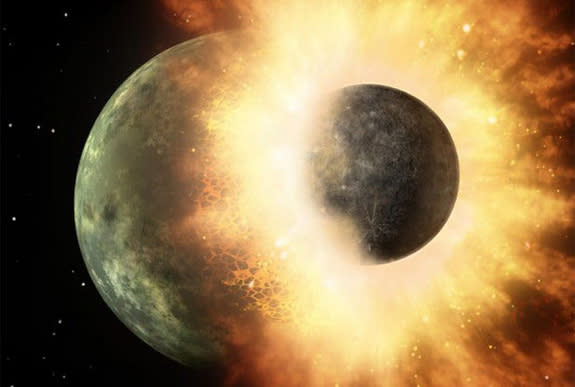Moon's Age Revealed, and a Lunar Mystery May Be SolvedSPACE.com
by Charles Q. Choi, SPACE.com Contributor 3 hours ago
 This artist's illustration depicts a giant impact between the early Earth and a Mars-size object, a cataclysmic collision thought to have created the moon about 4.5 billion years ago.
This artist's illustration depicts a giant impact between the early Earth and a Mars-size object, a cataclysmic collision thought to have created the moon about 4.5 billion years ago.Scientists have pinned down the birth date of the moon to within 100 million years of the birth of the solar system — the best timeline yet for the evolution of our planet's natural satellite.
This new discovery about the origin of the moon may help solve a mystery about why the moon and the Earth appear virtually identical in makeup, investigators added.
Scientists have suggested the moon was formed 4.5 billion years ago by a gigantic collision between a Mars-size object named Theia and Earth, a crash that would have largely melted the Earth. This model suggested that more than 40 percent of the moon was made up of debris from this impacting body. (Current theory suggests that Earth experienced several giant impacts during its formation, with the moon-forming impact being the last.)
However, researchers suspected Theia was chemically different from Earth. In contrast, recent studies revealed that the moon and Earth appear very similar when it comes to versions of elements called isotopes — more so than might be suggested by the current impact model. (Isotopes of an element have differing numbers of neutrons from one another.)
"This means that at the atomic level, the Earth and the moon are identical," study lead author Seth Jacobson, a planetary scientist at the Côte d'Azur Observatory in Nice, France, told Space.com. "This new information challenged the giant impact theory for lunar formation."
How the moon evolved
No one seriously disputed an impact as the most likely scenario for the formation of the moon, Jacobson said. However, a virtually atomically identical moon and Earth threw the exact circumstances of the collision into question, he said.
Now, by pinpointing when the moon formed, Jacobson and his colleagues could help explain why the moon and Earth are mysteriously similar. The scientists detailed their findings in the April 3 issue of the journal Nature.
Efforts to date the moon-forming impact have proposed a range of ages. Some have argued for an early event, about 30 million years after the birth of the solar system, whereas others suggested that it occurred more than 50 million years and possibly as much as 100 million years after the solar system formed.
To help solve this mystery, Jacobson and his colleagues simulated the growth of the solar system's rocky planets — Mercury, Venus, Earth and Mars — from a protoplanetary disk of thousands of planetary building blocks orbiting the sun.
By analyzing how these planets formed and grew from more than 250 computer simulations, the researchers discovered that if the moon-forming impact was early, the amount of material accreted onto Earth afterward was large. If the impact was late, the amount would then be small.
Past research had calculated the amount of material accreted onto Earth after the moon-forming impact. These estimates are based on how on how so-called highly siderophile or "iron-loving" elements such as iridium and platinum show a strong tendency to move into Earth's core. After each giant impact the nascent Earth sustained, these elements would have leached from Earth's mantle and bonded with heavy, iron-rich material destined to sink to Earth's heart.
Moon birth mystery
After the last giant impact that formed the moon, the mantle should have been almost completely stripped of iridium, platinum and their cousins. These elements are still present in the mantle, but only in small amounts, which suggests only a small amount of material accreted onto Earth after the moon-forming impact.
The researchers calculated the moon-forming impact must have occurred about 95 million years after the formation of the solar system, give or take 32 million years.
"A late moon-forming event, as suggested by our work, is very consistent with an identical Earth and moon," Jacobson said.
In addition, recent analyses propose that the impact that created the moon required a faster, more energetic collision than previously suggested. This makes sense if the impact took place relatively late with an older protoplanetary disk, as the new findings suggest.
"Older disks tend to be dynamically more active, since there are fewer bodies left in the disk to distribute energy amongst," Jacobson said.
These new findings raise an interesting new puzzle. While they suggest the moon and the Earth formed together nearly 100 million years after the solar system arose, evidence from meteorites from Mars suggests that the Red Planet formed as little as a few million years after the solar system was born.
"This means that Earth and Mars formed over dramatically different timescales, with Mars forming much faster than the Earth," Jacobson said. "How can this be? Is it just a matter of size? Location? What about Mercury and Venus? Did they grow on similar timescales to the Earth or on timescales more similar to Mars? I think these are some of the really important questions that we, as a community of planetary scientists, will be addressing in the future."
http://news.yahoo.com/moons-age-revealed-lunar-mystery-may-solved-172146898.html